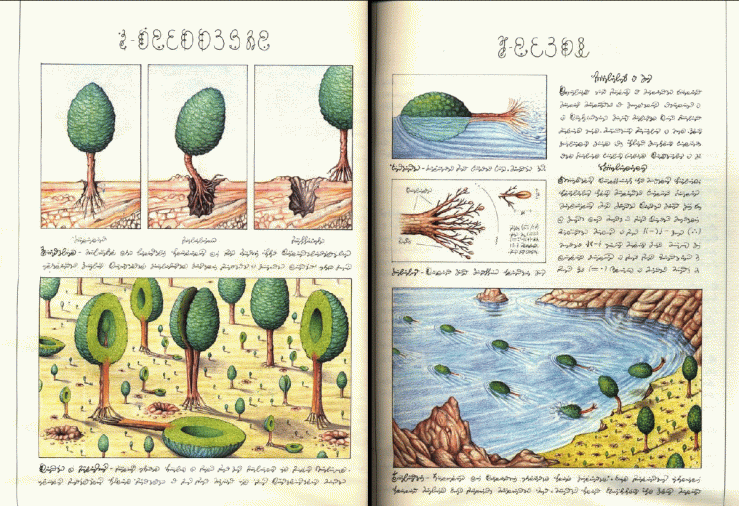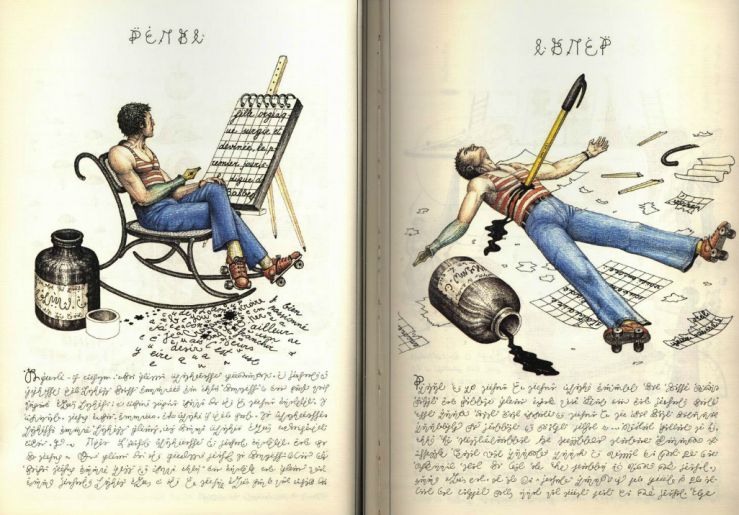First published in 1981, Codex Seraphinianus is an illustrated encyclopaedia of an imaginary world, created by Italian artist Luigi Serafini.
 “Organized in eminently logical fashion, it describes a system of knowledge that—at least in its structure—mirrors our own: here are botany, zoology, chemistry, physics, engineering, anatomy, anthropology, sociology, linguistics, and urban studies, each describing its object with a peculiarly recognizable exactitude.
“Organized in eminently logical fashion, it describes a system of knowledge that—at least in its structure—mirrors our own: here are botany, zoology, chemistry, physics, engineering, anatomy, anthropology, sociology, linguistics, and urban studies, each describing its object with a peculiarly recognizable exactitude.
Discover for yourself, reader, such wonders as the purple-caged citrus, the spider-web flower, the parfait protea, and the ladder weed. This is a world inhabited by weird half-sentient flora such as the tadpole tree and the meteor-fruit, by the lacy flying-saucer fish, the wheeled caterpillar-rumped horse, and the metamorphic bicranial rhino.
The planet’s sentient species are here as well—races like the Garbage-Dwellers, the Road-Traffic and the Yarn People, and the exotic Rodent-Skin Weaers… Nor can we forget to mention the Homo-Saurians, whose unusual sexual life-cycle is graphically described.
Merely to name these creatures is to confront the limits of our language.”
This is a short cover-jacket description of the journey about to be undertaken by the viewer* lucky enough to have obtained a copy of the Codex, which is rarely reprinted.
*Why viewer and not reader? The Codex, as scientific as it may look, is written in a systematised asemic language which Serafini invented. As the book is in essence an encyclopaedia , it only makes sense for it to be written in the language of the place it explores and thoroughly describes (even if that place is the product of one man’s fantastic imagination). Even though Serafini has stated himself that the text doesn’t mean anything, there have been many attempts to crack the code, the language of the book, but none have really been successful. However, the number system used has been deciphered (independently) by Allan C. Wechsler and Ivan Derzhanski (Bulgarian linguist, find his notes here), among others.
 When going through it we can tell that the Codex is divided into several parts beginning with a botanical chapter describing the world’s flora. From microorganisms and particles to larger increasingly-bizarre plants, trees and their processes and place within the environment. We begin to familiarise ourselves with the setting.
When going through it we can tell that the Codex is divided into several parts beginning with a botanical chapter describing the world’s flora. From microorganisms and particles to larger increasingly-bizarre plants, trees and their processes and place within the environment. We begin to familiarise ourselves with the setting.

The second part covers the fauna – surreal and oddly combined elements – animals and objects which create mind-twisting fusions and most of the time one ends up wondering how would this even work and what are the physical laws that allow for it…?
Imagination is pushing the edges of logical thinking and it’s pushing with the force of limitless potential. The sane mind has no chance against this book, a certain amount of madness is needed to appreciate such an astonishing piece of work.
The complexity increases with the third chapter where we explore the kingdom of unfamiliar bipedal creatures – they are a bit like what we would call centaurs but with the difference that these beings have humanoid legs and the upper body is… potentially anything you could think of.
The most captivating and mind-twisting part of the book is perhaps the fourth chapter – the one which covers what we can only imagine to be the scientific laws and physics which govern the world. Its almost abstract imagery brings science to the level of magic (all magic is just science we don’t understand yet) and truly makes you appreciate the complexity of this imaginary world. Imaginary worlds are governed by imaginary laws, but they are laws nonetheless.
Science leads to inventions so naturally, that is what the next chapter is all about. All the most bizarre machines, gadgets and technology.
The sixth chapter is devoted to the humanities. From biology to reproduction and sexuality, the diversity of peoples and studies of limbs or other body parts morphed into tools and objects…What you see below is one of the most famous and widely-recognised illustrations from the Codex. It’s pretty much self-explanatory.

The book continues with a chapter on the history of the world and its people – the early days, the developments of societies, political and religious systems and scenes, as well as different customs.
There is also a whole chapter describing the Codex’s writing system… in that same writing system – an inception of sorts. It is followed by a chapter on food, dining, clothing and fashion. Next come the games and sports activities, and the last chapter solely explores architecture.
I will finish with one of the pages I found most intriguing – the man with a pen for a hand, sitting in front of notepad on an easel. What I find so interesting about it is that it mirrors something which happens in our won world and that is scribbles – they mean nothing. Here we have spilled ink on the floor, and an arrangement of what initially would seem to be random scribbles but are in fact actual letters and words in French. Unfortunately I don;t know the language (yet) but it says something about an orgiastic girl emerging and guessing or wondering, and then something about the first days of the Blaba dam… (guessing at foreign languages is so much fun!)

There is so much more to the Codex but I will leave that for those curious enough to go through the whole thing themselves. It is indeed an astonishing (and frighteningly consistent) piece of work.
Below is a video interview with Serafini himself (yes, he is still alive) about how the codex came to be and what it’s all about.


























